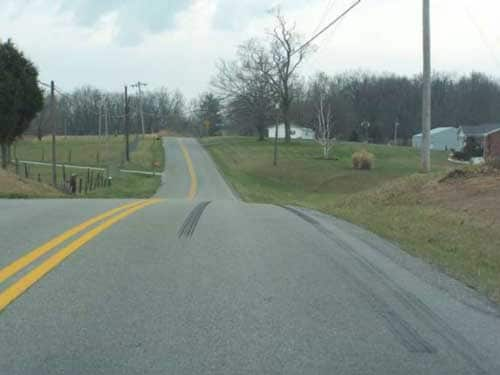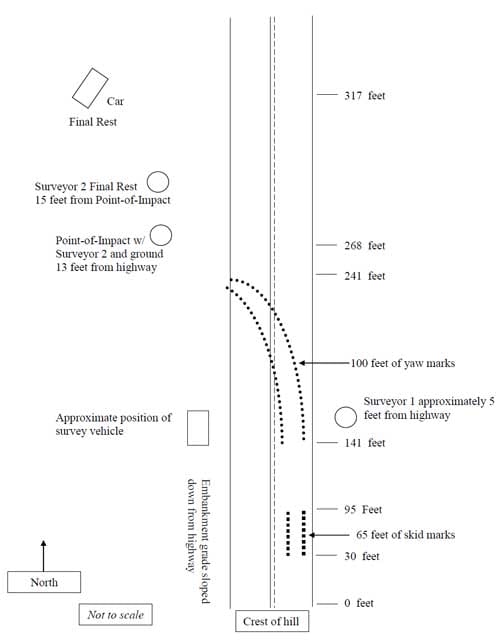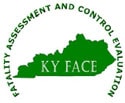Land Surveyor Struck and Killed By Passenger Vehicle
Kentucky Case Report: 09KY079
Report Release Date: January 11, 2011
Summary
One late fall day in 2009, at approximately 3:30 PM, two land surveyors had completed surveying tasks for the day and were walking north, on opposites sides of a two-lane rural state highway. They were returning surveying equipment to the company truck. Surveyor 1, company owner, was walking with traffic on the east side of the road, in the grass, a few feet to the right of the pavement. Surveyor 2 was walking on the edge of the pavement on the west side of the road. Both men were on the road on the blind side of a hill and there were no emergency shoulders. A passenger car traveling north, driven by a young driver, crested the hill. After cresting the hill, the driver saw the pedestrians, applied the brakes, and lost control of the vehicle. The vehicle skidded off the pavement toward Surveyor 2 on the left side of the road. Surveyor 2 saw the vehicle coming towards him and ran down the embankment away from the oncoming vehicle. The car left the pavement, became airborne, and landed on top of Surveyor 2. Emergency services were called. Upon arrival of EMS personnel, Surveyor 2 was transported via helicopter to the nearest trauma hospital where he died later that same day. He was 47 years old.
 |
|---|
|
Photograph of location where car topped hill and lost control. |
To prevent future occurrences of similar incidents, the following recommendations have been made:
- Recommendation No. 1: When surveying on land near roadways, safety cones and warning signage should be erected to slow down motorists.
- Recommendation No. 2: A hazard assessment should be performed before land-surveying work commences.
- Recommendation No. 3: Land surveying companies should have a comprehensive written safety program.
Background
The land surveying company for which the decedent worked had been in business since 1997
and had one full-time employee, the owner. The decedent had worked as a land surveyor for the
company on an as needed basis for one year. The company did not have a written safety
program. It is unknown how long the decedent had been a licensed professional land surveyor.
The temperature on the day of the incident ranged from 22 – 45 degrees Fahrenheit. There was
no recorded precipitation.
Investigation
The Kentucky Fatality Assessment and Control Evaluation program was notified via a state agency of an occupational fatality involving a land surveyor. A site visit was conducted and photographs were taken. Interviews were conducted with the accident reconstructionist, and the Kentucky Occupational Safety and Health inspector.
One late fall day in 2009, two professional land surveyors, Surveyor 1 (company owner) and Surveyor 2 (47 years old decedent), surveyed a farm that was divided by a rural, two-lane state highway. The surveying job required the surveyors to be in separate fields across the road from each other. Neither surveyor performed work on the highway itself. Because the survey work was more than 15 feet away from the highway, no road signs were placed on the highway to warn motorists there were workers in the fields. The highway ran north and south, with two lanes separated by yellow stripes. There were no white fog lines on either edge or emergency lanes. The speed limit was 55 miles per hour. The company truck was parked alongside the highway, parallel to the highway, on the southbound side.
At approximately 3:30 PM, the two land surveyors had completed surveying tasks for the day. They were walking south alongside the state highway, toward the company truck, carrying surveying equipment. Each surveyor wore a green reflective vest. Surveyor 1, owner of the surveying company, was walking in the grass, east of the highway, approximately four feet from the pavement. Surveyor 2 was walking on the west edge of the pavement. The land on Surveyor 2’s left side sloped down an embankment. Both men were on the north side of a hill in the road, on the blind side, if a vehicle was traveling from the south to the north. A car traveling north, driven by a young driver (over the age of 18), crested the hill. When the driver saw the pedestrians and surveyor truck, he applied the brakes, began to skid and lost control of the vehicle. The vehicle veered to the left side of the road toward Surveyor 2. Surveyor 2 saw the vehicle coming towards him and ran down the embankment away from the oncoming vehicle. The vehicle skidded for 65 feet, fishtailed for 100 feet, and became airborne over the embankment for 13 feet. The car landed on Surveyor 2, dragged him 15 feet, and then came to a rest several more feet away. Surveyor 1 witnessed the crash and at 3:36 PM called emergency medical services. Law enforcement arrived at 3:39 PM, found Surveyor 2 alive, and at 3:41 PM contacted dispatch and requested a medical helicopter to the scene. Ground emergency medical personnel arrived at 3:47 PM and prepared to transport Surveyor 2 to the helicopter’s landing site. The helicopter arrived at 4:00 PM, and transported Surveyor 2 to the nearest trauma hospital where they arrived at 4:20 PM. Surveyor 2 died at the hospital later that day.
The police report stated the pavement was asphalt, roadway conditions were straight and hillcrest, rural, dry, and the weather was clear. Human factors contributing to the incident were “speeding, inattention, and overcorrecting/ oversteering”. Environmental factors were “view obstructed/ limited”. No vehicle factors contributed to the incident. There were no obstacles in the roadway. The survey vehicle was parked in a field west of the highway.
Back to Top
Cause of Death
The death certificate states the cause of death was due to multiple blunt force injuries from a motor vehicle accident.
Recommendations/Discussion
Recommendation No. 1: When surveying on land near roadways, safety cones and warning signage should be erected to slow down motorists.
The Manual of Uniform Traffic Control Devices provides guidance on where to place warning signage when working on roadways. Since the land surveyors were not surveying along the roadway, signage and/ or orange cones warning motorists of workers on the roadway was not required. However, to be prudent, signage and/ or orange cones warning motorists of workers working near roadways should be placed prior to and at the work site. Position additional signage before hills, curves, or other obstacles to warn drivers of the work site located on the blind side of the hill, curve, etc.
Recommendation No. 2: A hazard assessment should be performed before land-surveying work commences.
A hazard assessment to identify worksite hazards should be performed before land surveying work begins. The hazard assessment should include vehicle parking, how to access the vehicle to safely retrieve and store equipment, and walking safely from the vehicle to the work site and back. Vehicles should be parked in a manner where they will be easily accessible by the surveying crew, and where the crew can walk to and from the vehicle away from traffic and other roadway hazards. Vehicles should be parked in an area where the vehicle will not be a hazard to traffic.
When walking on a rural roadway with no sidewalks, pedestrians should walk facing traffic, as far from the pavement as possible.
Recommendation No. 3: Land surveying companies should have a comprehensive written safety program.
The company did not have a written worker safety program. Elements of a comprehensive safety program for a land surveying company should include interaction with motor vehicle traffic in urban and rural areas, speeding drivers, exposure to wildlife and stinging insects, traversing rough terrain, interacting with angry landowners, exposure to biohazards, and exposure to the elements such as sun, rain, wind, and adverse temperatures. Protocols on walking in and around rural roadways should also be included in the safety program. Rural roadways typically do not have sidewalks or shoulders which force pedestrians to walk on the roadway with traffic, or along the side of the roadway on private property.
Hazard assessment procedures and first aid basics should be included in the safety program. Hazard assessments should include where to locate warning signage for motorists, where to locate the surveyor vehicle for safety and accessibility, how to identify terrain hazards, and how to navigate those hazards.
Keywords: Hazard assessment, Land surveyors, Signage
References
- United States Department of Labor, Occupational Safety and Health Administration, 1926, Subpart G, Signs, Signals, and Barricades, Standard 1926.200, Accident prevention signs and tagsexternal icon, https://www.osha.gov/pls/oshaweb/owadisp.show_document?p_id=10681&p_table=STANDARDS
- United States Department of Transportation, Federal Highway Administration, Manual on Uniform Traffic Control Devices, for Streets and Highways, 2009 Edition
Acknowledgements
Kentucky Occupational Safety and Health Compliance specialist
Local police officer/ reconstructionist
 |
|---|
Kentucky FACE Program
The Kentucky Fatality Assessment & Control Evaluation Program (FACE) is funded by a grant from the Centers for Disease Control and the National Institute of Safety and Health. The purpose of FACE is to aid in the research and prevention of occupational fatalities by evaluating events leading to, during, and after a work related fatality. Recommendations are made to help employers and employees to have a safer work environment. For more information about FACE and KIPRCexternal icon, please visit our website at: www.mc.uky.edu/kiprc/ (Link updated 3/27/2013)
To contact Kentucky State FACE program personnel regarding State-based FACE reports, please use information listed on the Contact Sheet on the NIOSH FACE web site. Please contact In-house FACE program personnel regarding In-house FACE reports and to gain assistance when State-FACE program personnel cannot be reached.
 external icon
external icon

This site contains documents in PDF format. You will need Adobe Acrobat Reader to access the file. If you do not have the Acrobat Reader, you may download a free copy from the Adobe Web siteexternal icon.
